Page 85 of 417
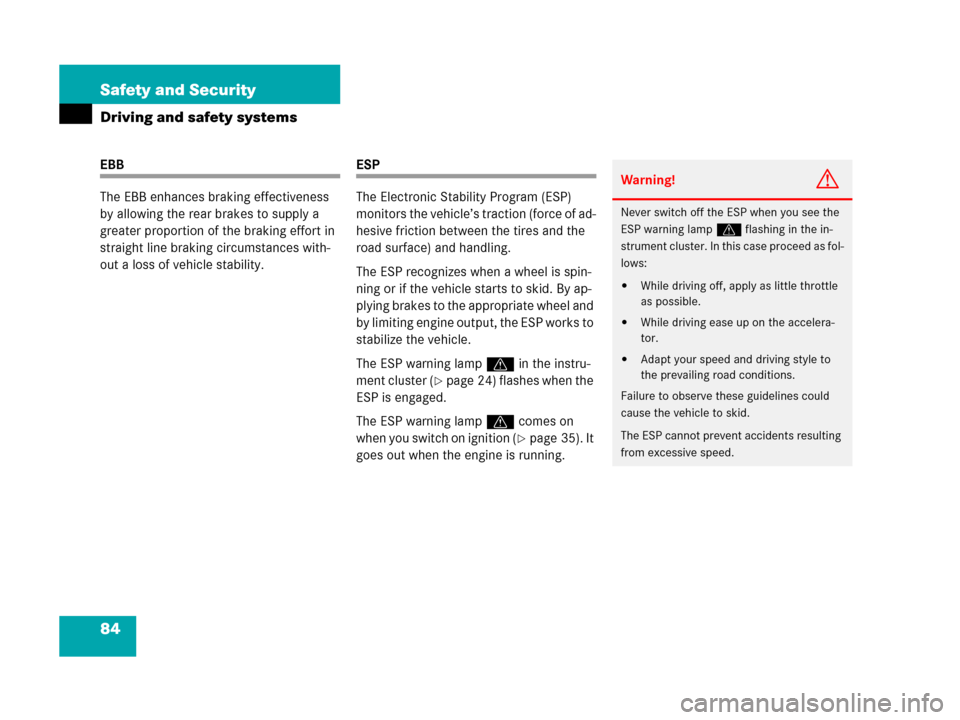
84 Safety and Security
Driving and safety systems
EBB
The EBB enhances braking effectiveness
by allowing the rear brakes to supply a
greater proportion of the braking effort in
straight line braking circumstances with-
out a loss of vehicle stability.ESP
The Electronic Stability Program (ESP)
monitors the vehicle’s traction (force of ad-
hesive friction between the tires and the
road surface) and handling.
The ESP recognizes when a wheel is spin-
ning or if the vehicle starts to skid. By ap-
plying brakes to the appropriate wheel and
by limiting engine output, the ESP works to
stabilize the vehicle.
The ESP warning lampv in the instru-
ment cluster (
�page 24) flashes when the
ESP is engaged.
The ESP warning lampv comes on
when you switch on ignition (
�page 35). It
goes out when the engine is running.
Warning!G
Never switch off the ESP when you see the
ESP warning lamp v flashing in the in-
strument cluster. In this case proceed as fol-
lows:
�While driving off, apply as little throttle
as possible.
�While driving ease up on the accelera-
tor.
�Adapt your speed and driving style to
the prevailing road conditions.
Failure to observe these guidelines could
cause the vehicle to skid.
The ESP cannot prevent accidents resulting
from excessive speed.
Page 86 of 417
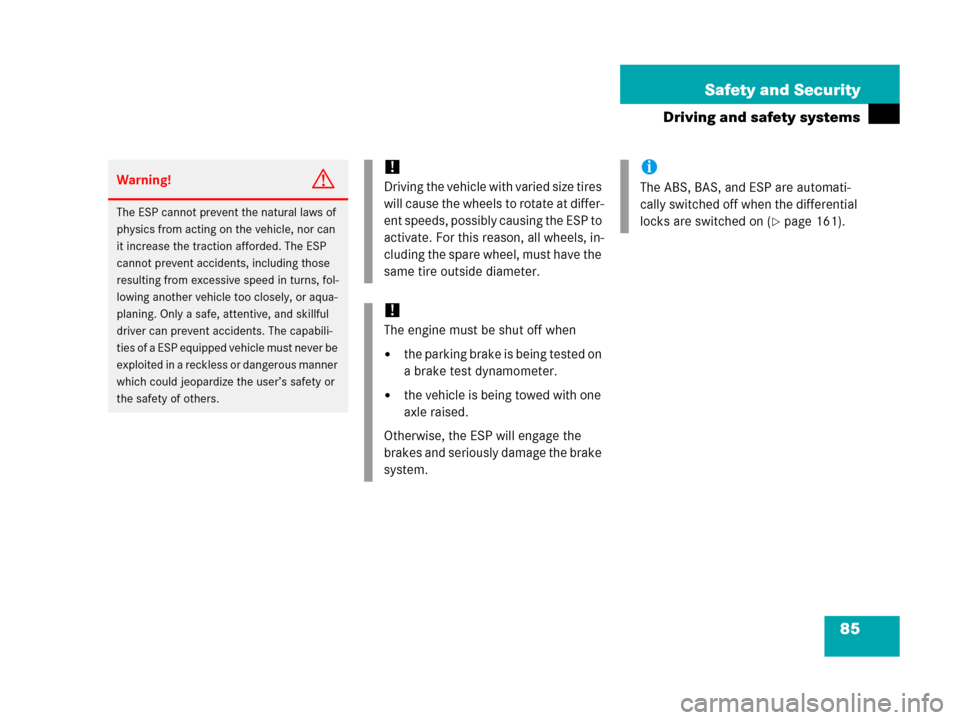
85 Safety and Security
Driving and safety systems
Warning!G
The ESP cannot prevent the natural laws of
physics from acting on the vehicle, nor can
it increase the traction afforded. The ESP
cannot prevent accidents, including those
resulting from excessive speed in turns, fol-
lowing another vehicle too closely, or aqua-
planing. Only a safe, attentive, and skillful
driver can prevent accidents. The capabili-
ties of a ESP equipped vehicle must never be
exploited in a reckless or dangerous manner
which could jeopardize the user’s safety or
the safety of others.
!
Driving the vehicle with varied size tires
will cause the wheels to rotate at differ-
ent speeds, possibly causing the ESP to
activate. For this reason, all wheels, in-
cluding the spare wheel, must have the
same tire outside diameter.
!
The engine must be shut off when
�the parking brake is being tested on
a brake test dynamometer.
�the vehicle is being towed with one
axle raised.
Otherwise, the ESP will engage the
brakes and seriously damage the brake
system.
i
The ABS, BAS, and ESP are automati-
cally switched off when the differential
locks are switched on (
�page 161).
Page 88 of 417
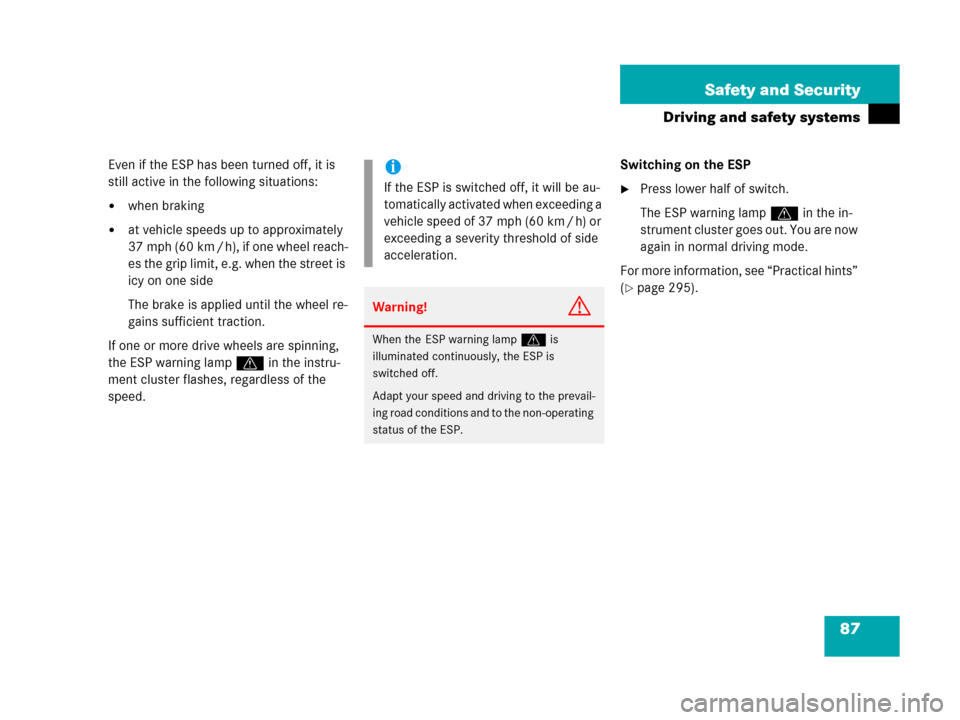
87 Safety and Security
Driving and safety systems
Even if the ESP has been turned off, it is
still active in the following situations:
�when braking
�at vehicle speeds up to approximately
37 mph (60 km / h), if one wheel reach-
es the grip limit, e.g. when the street is
icy on one side
The brake is applied until the wheel re-
gains sufficient traction.
If one or more drive wheels are spinning,
the ESP warning lampv in the instru-
ment cluster flashes, regardless of the
speed.Switching on the ESP
�Press lower half of switch.
The ESP warning lampv in the in-
strument cluster goes out. You are now
again in normal driving mode.
For more information, see “Practical hints”
(
�page 295).
i
If the ESP is switched off, it will be au-
tomatically activated when exceeding a
vehicle speed of 37 mph (60 km / h) or
exceeding a severity threshold of side
acceleration.
Warning!G
When the ESP warning lampv is
illuminated continuously, the ESP is
switched off.
Adapt your speed and driving to the prevail-
ing road conditions and to the non-operating
status of the ESP.
Page 151 of 417
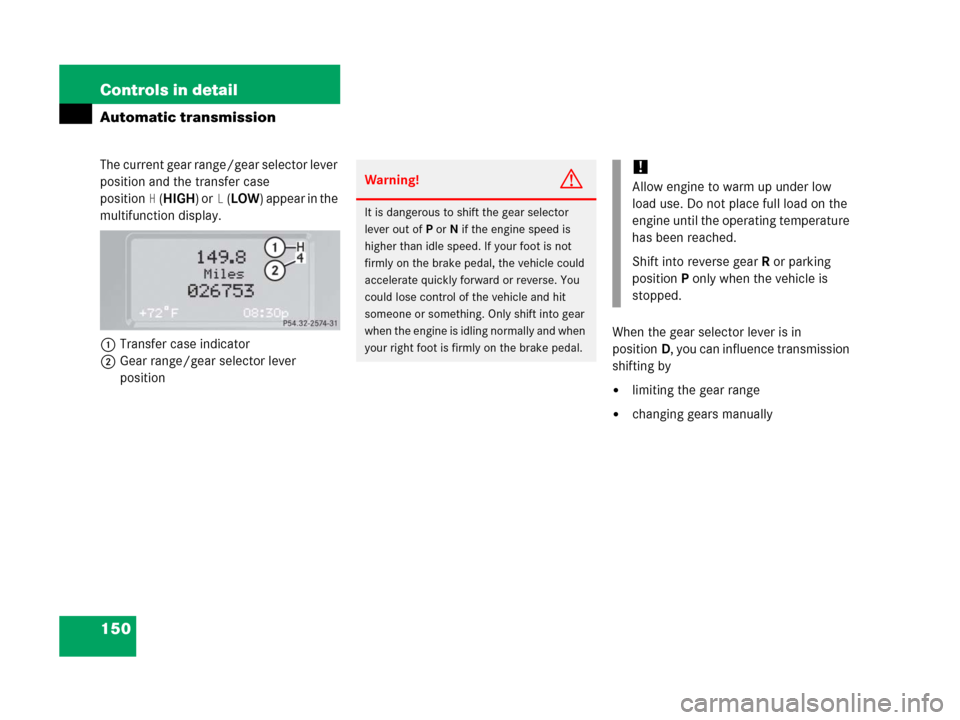
150 Controls in detail
Automatic transmission
The current gear range/gear selector lever
position and the transfer case
position
H(HIGH) orL(LOW) appear in the
multifunction display.
1Transfer case indicator
2Gear range/gear selector lever
positionWhen the gear selector lever is in
positionD, you can influence transmission
shifting by
�limiting the gear range
�changing gears manually
Warning!G
It is dangerous to shift the gear selector
lever out ofP orN if the engine speed is
higher than idle speed. If your foot is not
firmly on the brake pedal, the vehicle could
accelerate quickly forward or reverse. You
could lose control of the vehicle and hit
someone or something. Only shift into gear
when the engine is idling normally and when
your right foot is firmly on the brake pedal.
!
Allow engine to warm up under low
load use. Do not place full load on the
engine until the operating temperature
has been reached.
Shift into reverse gearR or parking
positionP only when the vehicle is
stopped.
Page 152 of 417

151 Controls in detail
Automatic transmission
Gear selector lever position
Effect
ìPark position
Gear selector lever position
when the vehicle is parked. Place
gear selector lever in positionP
only when vehicle is stopped.
The park position is not intended
to serve as a brake when the
vehicle is parked. Rather, the
driver should always set the
parking brake in addition to
placing the gear selector lever in
positionP to secure the vehicle.
Effect
The SmartKey can only be
removed from the starter switch
with the gear selector lever in
positionP. With the SmartKey
removed, the gear selector lever
is locked in positionP.
If the vehicle’s electrical system
is malfunctioning, the gear
selector lever could remain
locked in positionP
(
�page 329).
íReverse gear
Place gear selector lever in
positionR only when vehicle is
stopped.
Effect
ëNeutral
No power is transmitted from the
engine to the drive axle. When
the brakes are released, the
vehicle can be moved freely
(pushed or towed).
Do not engageN while driving
except:
�to coast when vehicle is in
danger of skidding (e.g. on
icy roads) when the ESP is
deactivated or malfunction-
ing
�when you have to shift the
transfer case
êDrive
The transmission shifts
automatically. All five forward
gears are available.
Page 153 of 417

152 Controls in detail
Automatic transmission
!
Coasting the vehicle, or driving for any
other reason with gear selector lever
inN can result in transmission damage
that is not covered by the
Mercedes-Benz Limited Warranty.Warning!G
Getting out of your vehicle with the gear se-
lector lever not fully engaged in positionP is
dangerous. Also, positionP alone is not in-
tended to or capable of preventing your ve-
hicle from moving, possibly hitting people or
objects.
Always set the parking brake in addition to
shifting to positionP (
�page 57).
When parked on an incline, turn the front
wheels towards the road curb.
Do not park this vehicle in areas where com-
bustible materials such as grass, hay or
leaves can come into contact with the hot
exhaust system, as these materials could be
ignited and cause a vehicle fire.
Warning!G
When leaving the vehicle, always remove the
SmartKey from the starter switch, take it
with you, and lock the vehicle. Do not leave
children unattended in the vehicle, or with
access to an unlocked vehicle. Children
could move the gear selector lever from
positionP, which could result in an accident
and/or serious personal injury.
Page 154 of 417
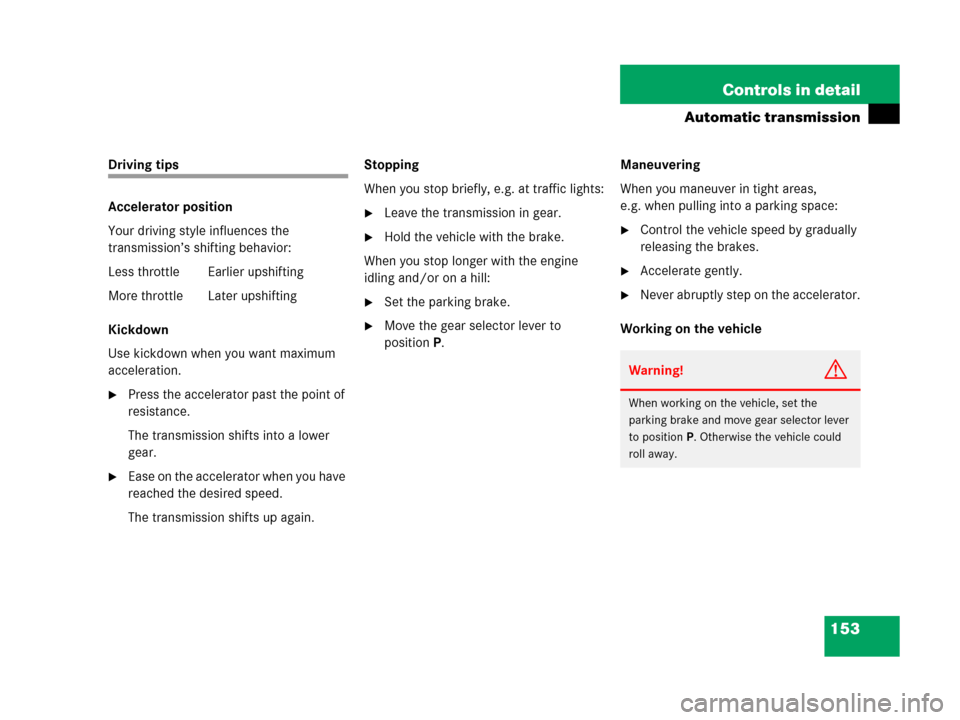
153 Controls in detail
Automatic transmission
Driving tips
Accelerator position
Your driving style influences the
transmission’s shifting behavior:
Less throttle Earlier upshifting
More throttle Later upshifting
Kickdown
Use kickdown when you want maximum
acceleration.
�Press the accelerator past the point of
resistance.
The transmission shifts into a lower
gear.
�Ease on the accelerator when you have
reached the desired speed.
The transmission shifts up again.Stopping
When you stop briefly, e.g. at traffic lights:
�Leave the transmission in gear.
�Hold the vehicle with the brake.
When you stop longer with the engine
idling and/or on a hill:
�Set the parking brake.
�Move the gear selector lever to
positionP.Maneuvering
When you maneuver in tight areas,
e.g. when pulling into a parking space:
�Control the vehicle speed by gradually
releasing the brakes.
�Accelerate gently.
�Never abruptly step on the accelerator.
Working on the vehicle
Warning!G
When working on the vehicle, set the
parking brake and move gear selector lever
to positionP. Otherwise the vehicle could
roll away.
Page 159 of 417
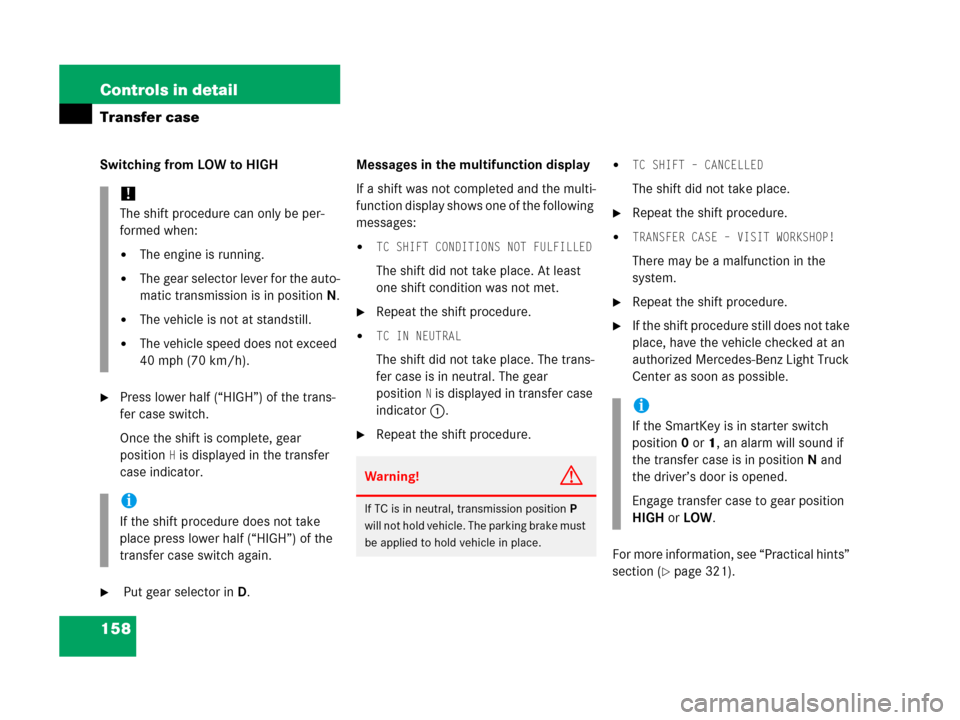
158 Controls in detail
Transfer case
Switching from LOW to HIGH
�Press lower half (“HIGH”) of the trans-
fer case switch.
Once the shift is complete, gear
position
H is displayed in the transfer
case indicator.
� Put gear selector in D.Messages in the multifunction display
If a shift was not completed and the multi-
function display shows one of the following
messages:
�TC SHIFT CONDITIONS NOT FULFILLED
The shift did not take place. At least
one shift condition was not met.
�Repeat the shift procedure.
�TC IN NEUTRAL
The shift did not take place. The trans-
fer case is in neutral. The gear
position
N is displayed in transfer case
indicator1.
�Repeat the shift procedure.
�TC SHIFT – CANCELLED
The shift did not take place.
�Repeat the shift procedure.
�TRANSFER CASE – VISIT WORKSHOP!
There may be a malfunction in the
system.
�Repeat the shift procedure.
�If the shift procedure still does not take
place, have the vehicle checked at an
authorized Mercedes-Benz Light Truck
Center as soon as possible.
For more information, see “Practical hints”
section (
�page 321).
!
The shift procedure can only be per-
formed when:
�The engine is running.
�The gear selector lever for the auto-
matic transmission is in positionN.
�The vehicle is not at standstill.
�The vehicle speed does not exceed
40 mph (70 km/h).
i
If the shift procedure does not take
place press lower half (“HIGH”) of the
transfer case switch again.
Warning!G
If TC is in neutral, transmission positionP
will not hold vehicle. The parking brake must
be applied to hold vehicle in place.
i
If the SmartKey is in starter switch
position0 or1, an alarm will sound if
the transfer case is in positionN and
the driver’s door is opened.
Engage transfer case to gear position
HIGH or LOW.